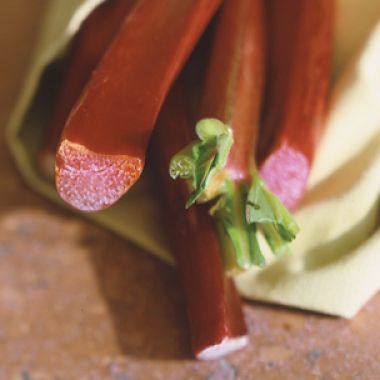All About Rhubarb

Although technically a vegetable, rhubarb is treated like a fruit in the kitchen. Its long, celery-like stalks range in color from cherry red to pale pink. Rhubarb usually is cooked with a good dose of sugar to balance its tartness. The delicious transformation after sweetening and cooking has earned rhubarb the nickname "pie plant."
Although hothouse-grown rhubarb is available all year in some areas, field-grown rhubarb is a spring crop, with the bulk appearing in April and May. Rhubarb is often paired with strawberries, which appear in the same season and provide a contrasting sweetness. Oranges are another common flavor pairing.
A favorite for pies and tarts, rhubarb is also wonderful in jams and preserves. Rhubarb chutneys and relishes are an excellent accompaniment to roast pork, duck and Cornish game hens.
Selecting
Look for crisp, firm stalks without blemishes or cuts and with good color. Avoid rhubarb stalks that are turning from red or pink to green. Field-grown rhubarb has a bright red color and a more pronounced flavor than pale pink hothouse-grown stalks. Any leaves attached to the stalks should be fresh looking, not wilted, although the leaves should not be eaten because they are toxic.
Storing
Whole stalks can be refrigerated for up to 3 days. Store them in the crisper in perforated plastic bags.
Preparing
Trim away the leaves and stalk ends and peel any brown spots. If stalks are fibrous, remove the strings with a vegetable peeler. Stalks that are more than 1 1⁄2 inches wide should be halved lengthwise.
Adapted from Williams-Sonoma Kitchen Companion: The A to Z Guide to Everyday Cooking, Equipment and Ingredients (Time-Life Books, 2000)